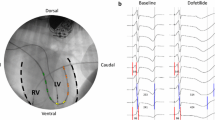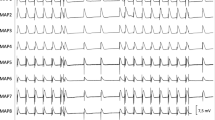Summary
This study examined the effects of 2% halothane general anesthesia on ventricular electrophysiological properties and inducibility of sustained ventricular tachycardia (VT) and ventricular fibrillation (VF). Dogs with chronic anterior infarction and control dogs (no infarction) were studied before and after anesthesia using chronically implanted ventricular epicardial electrodes. PQ interval was increased by 15% with halothane, but QRS duration, QT interval, QTc, and sinus rhythm cycle length were unaffected by anesthesia. Diastolic threshold was unchanged by halothane. Halothane caused significant increases of 10–30% in ventricular effective refractory period (ERP) both in control and in infarct animals. VT and VF were not inducible in any of the nine control animals either before or after anesthesia. In infarct animals 34 of 75 (45%) had inducible VT or VF prior to halothane, but the incidence of inducible arrhythmias was significantly lower at 29% (22 of 75 animals) after halothane (p<0.01). In 75% of animals in which halothane suppressed inducibility of tachyarrhythmias, halothane-induced increases in ERP prevented achievement of the short extrastimulus coupling intervals at which the arrhythmias were induced before anesthesia. In conclusion: halothane anesthesia reduces the incidence of inducible sustained ventricular tachyarrhythmias in chronic canine myocardial infarction.
Similar content being viewed by others
References
Atlee JL (1985) Anesthesia and cardiac electrophysiology. Eur J Anesthesiology 2:215–256
Atlee JL, Peterson JL (1982) Halothane, isoflurane, enflurane and AV conduction. Awake vs anesthesia (Abstract). Anesthesiology 57:A15
Bosnjak ZJ, Kampine JP (1983) Effects of halothane, enflurane and isoflurane on the SA node. Anesthesiology 58:314–321
Hashimoto K, Hashimoto K (1972) The mechanism of sensitization of the ventricle to epinephrine by halothane. Am Heart J 83:652–658
Joas TZ, Stevens WC (1971) Comparison of the arrhythmic doses of epinephrine during forane, halothane and fluoroxene anesthesia in dogs. Anesthesiology 35:48–53
Johnston RR, Eger EI, Wilson C (1976) A comparative interaction of epinephrine with enflurane, isoflurane and halothane in man. Anesth Analg 55:709–712
Logic JR, Morrow DH (1972) The effect of halothane on ventricular automaticity. Anesthesiology 36:107–110
Lynch C, Vogel S, Sperclakis N (1981) Halothane depression of myocardial slow action potentials. Anesthesiology 55:360–368
Morrow DH, Knapp DE, Logic JR (1970) Anesthesia and digitalis toxicity. V: Effect of the vagus on ouabain-induced ventricular automaticity during halothane. Anesth Analg 49:23–27
Pratila MG, Pratilas V (1978) Anesthetic agents and cardiac electromechanical activity. Anesthesiology 49:338–360
Price HL (1966) The significance of catecholamine release during anesthesia. Br J Anesth 38:705–711
Price HL, Ohnishi ST (1980) Effects of anesthetics on the heart. Fed Proc 39:1575–1579
Remington RD, Schork MA (1970) Statistics with applications to the biological and health sciences. Prentice-Hall, Englewood Cliffs, pp 243–244
Reynolds AK, Chiz JF, Pasquet AF (1970) Halothane and methoxyflurane. A comparison of their effects on cardiac pacemaker fibers. Anesthesiology 33:602–610
Richards DA, Cody DV, Denniss AR, Russell PA, Young AA, Uther JB (1983) A new protocol of programmed stimulation for assessment of predisposition to spontaneous ventricular arrhythmias. Eur Heart J 4:376–382
Tucker WK, Rackstein AD, Munson ES (1974) Comparison of arrhythmic doses of adrenaline, metaraminol, ephedrine and phenylephrine during isoflurane and halothane anesthesia in dogs. Br J Anesth 46:392–396
Author information
Authors and Affiliations
Additional information
A preliminary report of this study was given to the American Heart Association, Dallas, Texas, USA, November 1986.
Rights and permissions
About this article
Cite this article
Denniss, A.R., Richards, D.A., Taylor, A.T. et al. Halothane anesthesia reduces inducibility of ventricular tachyarrhythmias in chronic canine myocardial infarction. Basic Res Cardiol 84, 5–12 (1989). https://doi.org/10.1007/BF01906998
Received:
Issue Date:
DOI: https://doi.org/10.1007/BF01906998




